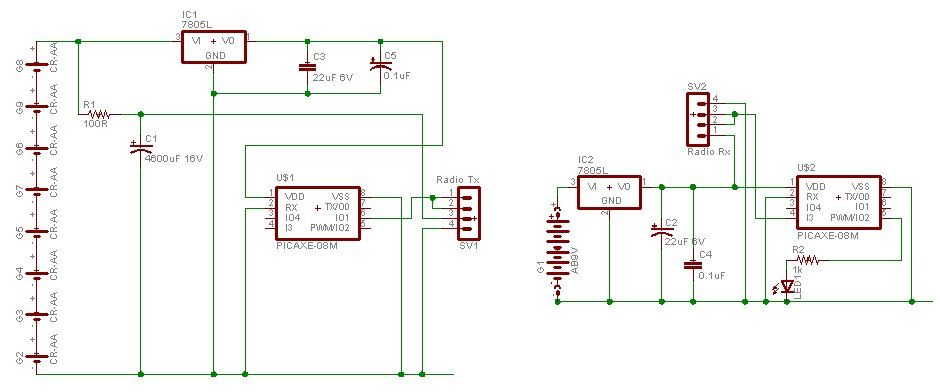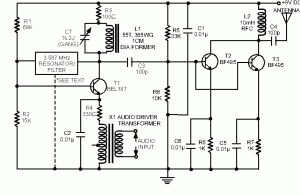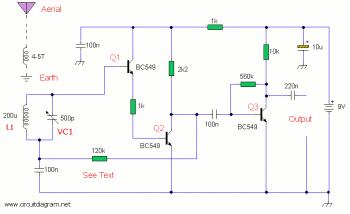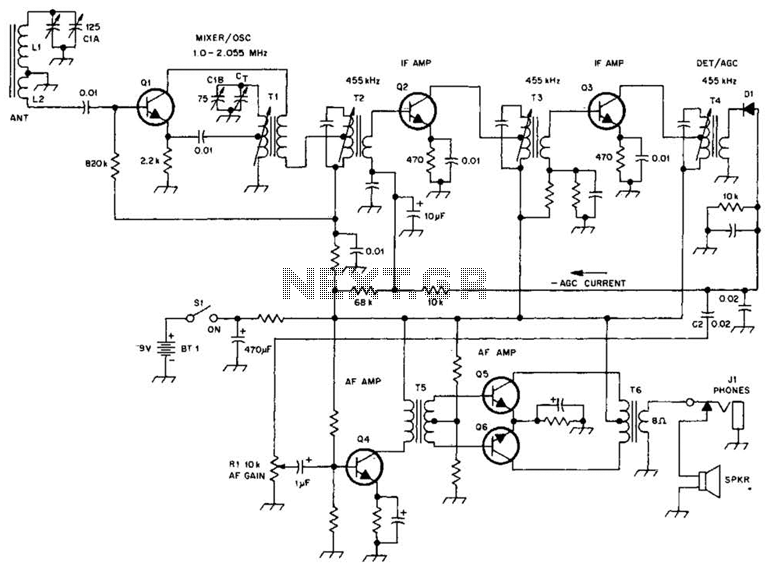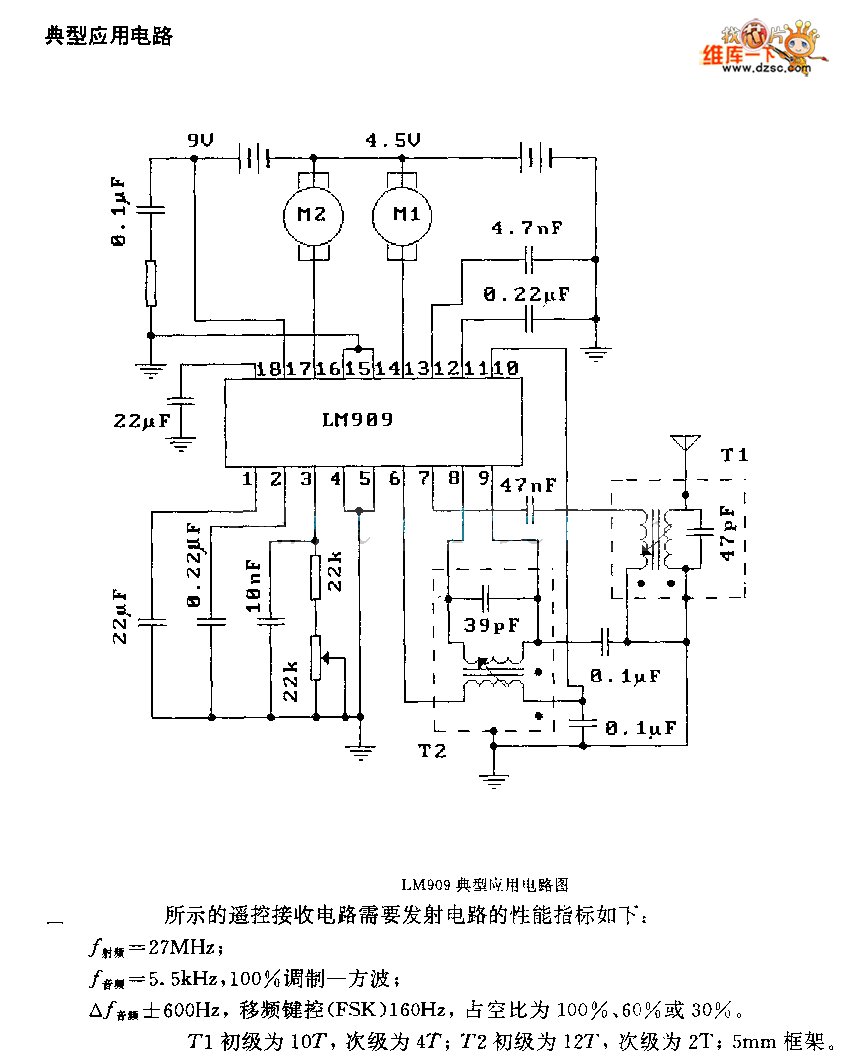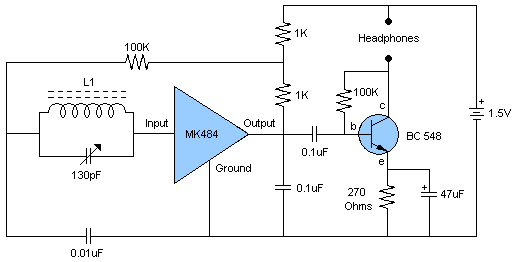
fm radio receivers
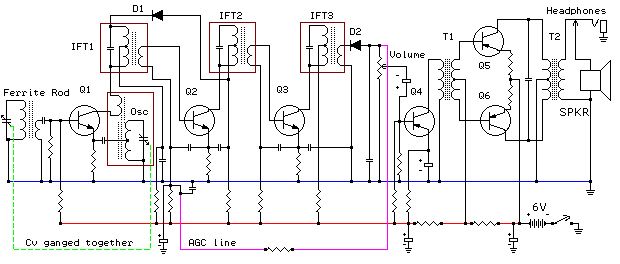
An AM receiver depends on the original carrier signal (station frequency) being amplitude modulated, meaning the original amplitude (strength) varies at an audio rate. Figure 1 illustrates an unmodulated carrier signal as it might appear on an oscilloscope, showing that the amplitude remains constant in height from the top to the bottom of the figure. This carrier is common to both AM and FM signals. The AM carrier signal repeats each cycle from point (a) to point (b) - "blue" - in Figure 2 below at a rate of 810,000 times a second, representing a frequency of 810 kHz, which falls within the AM radio band. The audio modulating signal, depicted in red, varies the strength of the carrier signal, represented in green for this illustration. In the receiver circuit, a diode detector can convert the varying envelope back into the original audio signal for amplification, although some distortion may occur. This distortion led to the search for improved transmission methods. Additionally, it was discovered that noise (both man-made QRM and natural noise QRN) also had amplitude properties. Two blue lines in the diagram represent noise impulses, potentially caused by automobile ignition, nearby fluorescent lighting, computers, or atmospheric disturbances such as distant storms. These lines extend beyond the amplitude envelope and can exceed the magnitude of the received signal. For these reasons, frequency modulation (FM) was developed. Instead of varying the amplitude of the carrier signal, which remains constant, the carrier frequency is varied in accordance with the audio frequency.
An AM receiver circuit typically includes several key components: an antenna, a radio frequency (RF) amplifier, a mixer, a demodulator (or detector), and an audio amplifier. The antenna captures the AM broadcast signal, which is then amplified by the RF amplifier to improve the signal strength and reduce noise. The amplified signal is fed into a mixer, where it is combined with a local oscillator signal to produce an intermediate frequency (IF) signal. This IF signal is easier to process and filter.
The demodulator is a crucial component of the AM receiver, responsible for extracting the audio information from the modulated carrier wave. A common type of demodulator used in AM receivers is the envelope detector, which utilizes a diode to rectify the incoming signal. The diode allows current to flow only during the positive half-cycles of the AM signal, effectively removing the negative half-cycles and creating a varying voltage that corresponds to the original audio signal. A capacitor is typically used in conjunction with the diode to smooth the output, filtering out high-frequency components and leaving the audio signal intact.
After demodulation, the audio signal may still contain some noise and distortion. Therefore, it is sent to an audio amplifier, which boosts the signal to a level suitable for driving speakers or headphones. The audio amplifier may include additional filtering stages to further reduce noise and improve sound quality.
In summary, the AM receiver circuit efficiently converts amplitude-modulated signals into audible audio signals while addressing challenges such as noise and distortion. The evolution of AM technology has paved the way for more advanced modulation techniques like FM, which offer improved sound quality by varying the carrier frequency instead of amplitude.An AM receiver relies upon the original carrier signal (station frequency) having been amplitude modulated. This means the original amplitude (strength) varies at an audio rate. Looking at figure 1 we can see an unmodulated carrier signal as it might be seen on an oscilloscope. as you can see the amplitude of the carrier signal is unvarying, it remains constant in height looking
from the top of the figure to the bottom of the figure. This carrier is common to both a. m. and f. m. signals. Perhaps the a. m. carrier signal repeats each cycle from point (a) to point (b) - "blue" - in figure 2 below at the rate of 810, 000 times a second, this represents a frequency of 810 Khz and would be in the a. m. radio band. Here you will notice that the audio modulating signal which is depicted in red has varied the strength of the carrier signal which is depicted green for purposes of this illustration.
You will note my skills as a graphic artist leave much to be desired (hint: anyone able to contribute oscillograghs in. jpg or. gif formats ) but you should be able to see the carrier sine wave envelope is being varied in strength by the red audio signal.
In the receiver circuit a diode detector can convert that envelope above back into the original audio signal for later amplification although some distortion does result. It was to an extent this distortion property that people sought a better means of transmission. More important it was discovered that noise (either man made QRM or natural noise QRN) was amplitude in its properties.
I have depicted two blue lines in the diagram above, these represent noise impulses caused perhaps by automobile ignition, nearby fluorescent lighting, your computer or atmospheric noise such as a distant storm. Note the blue lines extend beyond the amplitude envelope, they could be many times the magnitude of the received signal.
For these reasons frequency modulation evolved. Instead of varying the amplitude of the carrier signal, which remains constant, we vary the carrier frequency more or less by the audio frequency. 🔗 External reference
An AM receiver circuit typically includes several key components: an antenna, a radio frequency (RF) amplifier, a mixer, a demodulator (or detector), and an audio amplifier. The antenna captures the AM broadcast signal, which is then amplified by the RF amplifier to improve the signal strength and reduce noise. The amplified signal is fed into a mixer, where it is combined with a local oscillator signal to produce an intermediate frequency (IF) signal. This IF signal is easier to process and filter.
The demodulator is a crucial component of the AM receiver, responsible for extracting the audio information from the modulated carrier wave. A common type of demodulator used in AM receivers is the envelope detector, which utilizes a diode to rectify the incoming signal. The diode allows current to flow only during the positive half-cycles of the AM signal, effectively removing the negative half-cycles and creating a varying voltage that corresponds to the original audio signal. A capacitor is typically used in conjunction with the diode to smooth the output, filtering out high-frequency components and leaving the audio signal intact.
After demodulation, the audio signal may still contain some noise and distortion. Therefore, it is sent to an audio amplifier, which boosts the signal to a level suitable for driving speakers or headphones. The audio amplifier may include additional filtering stages to further reduce noise and improve sound quality.
In summary, the AM receiver circuit efficiently converts amplitude-modulated signals into audible audio signals while addressing challenges such as noise and distortion. The evolution of AM technology has paved the way for more advanced modulation techniques like FM, which offer improved sound quality by varying the carrier frequency instead of amplitude.An AM receiver relies upon the original carrier signal (station frequency) having been amplitude modulated. This means the original amplitude (strength) varies at an audio rate. Looking at figure 1 we can see an unmodulated carrier signal as it might be seen on an oscilloscope. as you can see the amplitude of the carrier signal is unvarying, it remains constant in height looking
from the top of the figure to the bottom of the figure. This carrier is common to both a. m. and f. m. signals. Perhaps the a. m. carrier signal repeats each cycle from point (a) to point (b) - "blue" - in figure 2 below at the rate of 810, 000 times a second, this represents a frequency of 810 Khz and would be in the a. m. radio band. Here you will notice that the audio modulating signal which is depicted in red has varied the strength of the carrier signal which is depicted green for purposes of this illustration.
You will note my skills as a graphic artist leave much to be desired (hint: anyone able to contribute oscillograghs in. jpg or. gif formats ) but you should be able to see the carrier sine wave envelope is being varied in strength by the red audio signal.
In the receiver circuit a diode detector can convert that envelope above back into the original audio signal for later amplification although some distortion does result. It was to an extent this distortion property that people sought a better means of transmission. More important it was discovered that noise (either man made QRM or natural noise QRN) was amplitude in its properties.
I have depicted two blue lines in the diagram above, these represent noise impulses caused perhaps by automobile ignition, nearby fluorescent lighting, your computer or atmospheric noise such as a distant storm. Note the blue lines extend beyond the amplitude envelope, they could be many times the magnitude of the received signal.
For these reasons frequency modulation evolved. Instead of varying the amplitude of the carrier signal, which remains constant, we vary the carrier frequency more or less by the audio frequency. 🔗 External reference
